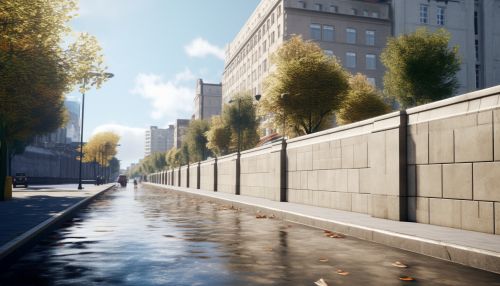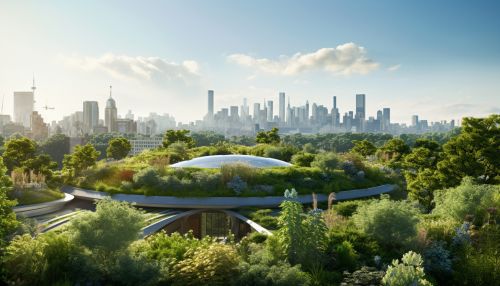Climate Change Adaptation in Cities
Introduction
Climate change adaptation in cities involves the implementation of policies and measures aimed at reducing the vulnerability and enhancing the resilience of urban areas to the impacts of climate change. This includes both physical changes to the urban environment, such as the construction of flood defenses or the creation of green spaces to absorb rainfall and reduce urban heat island effects, as well as changes to planning and management practices, such as incorporating climate change considerations into urban planning processes or developing emergency response plans for extreme weather events.


Understanding Climate Change Adaptation in Cities
Climate change poses a significant threat to cities, particularly those in coastal or low-lying areas, which are at risk from sea-level rise and increased frequency and severity of storms and flooding. Cities are also vulnerable to heatwaves, droughts, and other extreme weather events, which are expected to become more frequent and severe as a result of climate change. These impacts can have serious consequences for urban infrastructure, economies, and populations, particularly those in low-income or marginalized communities who are often most vulnerable to the impacts of climate change[^1^].
Adaptation to climate change in cities therefore involves a range of strategies and measures aimed at reducing these risks and enhancing the capacity of cities to cope with the impacts of climate change. These can include both 'hard' measures, such as the construction of physical defenses against sea-level rise or flooding, and 'soft' measures, such as changes to planning and management practices to incorporate climate change considerations, or the development of community-based adaptation initiatives[^2^].
Approaches to Climate Change Adaptation in Cities
Infrastructure Adaptation
Infrastructure adaptation involves changes to the physical infrastructure of cities to reduce vulnerability to climate change impacts. This can include the construction of sea walls or flood defenses to protect against sea-level rise and flooding, the installation of cooling systems or shading structures to reduce heat stress during heatwaves, or the creation of water storage or recycling systems to cope with droughts[^3^].


Green Infrastructure and Ecosystem-Based Adaptation
Green infrastructure and ecosystem-based adaptation involve the use of natural or semi-natural systems to provide climate change adaptation benefits. This can include the creation of green spaces or green roofs to absorb rainfall and reduce urban heat island effects, the preservation or restoration of urban wetlands to act as natural flood defenses, or the planting of urban forests to sequester carbon and improve air quality[^4^].


Planning and Management Adaptation
Planning and management adaptation involves changes to urban planning and management practices to incorporate climate change considerations. This can include the integration of climate change risk assessments into urban planning processes, the development of climate change adaptation plans or strategies, or the implementation of regulations or incentives to encourage climate change adaptation actions[^5^].


Community-Based Adaptation
Community-based adaptation involves the development and implementation of climate change adaptation initiatives at the community level. This can include the establishment of community emergency response teams for extreme weather events, the development of community gardens or urban farms to improve food security, or the implementation of education or awareness-raising programs to increase understanding of climate change risks and adaptation options[^6^].


Challenges and Opportunities
While there are many potential strategies and measures for climate change adaptation in cities, implementing these can present a range of challenges. These can include technical challenges, such as the complexity of designing and implementing effective adaptation measures, financial challenges, such as the high costs of adaptation and the lack of funding or resources, and institutional challenges, such as the lack of coordination or cooperation between different actors or sectors[^7^].
However, there are also many opportunities for climate change adaptation in cities. These include the potential for adaptation measures to provide multiple benefits, such as improved air quality, increased biodiversity, or enhanced community well-being, the potential for cities to act as innovation hubs for the development and testing of new adaptation technologies or approaches, and the potential for adaptation to contribute to broader urban sustainability or resilience goals[^8^].
Conclusion
Climate change adaptation in cities is a complex and multifaceted issue, requiring a range of strategies and measures to reduce vulnerability and enhance resilience. While there are many challenges to implementing these measures, there are also many opportunities, and cities have a critical role to play in the global response to climate change.
See Also
References
[^1^]: Rosenzweig, C., Solecki, W., Hammer, S. A., & Mehrotra, S. (2011). Climate change and cities: First assessment report of the Urban Climate Change Research Network. Cambridge University Press. [^2^]: Bulkeley, H., & Betsill, M. (2005). Rethinking sustainable cities: Multilevel governance and the 'urban' politics of climate change. Environmental Politics, 14(1), 42-63. [^3^]: Hallegatte, S., Green, C., Nicholls, R. J., & Corfee-Morlot, J. (2013). Future flood losses in major coastal cities. Nature Climate Change, 3(9), 802-806. [^4^]: Gill, S. E., Handley, J. F., Ennos, A. R., & Pauleit, S. (2007). Adapting cities for climate change: the role of the green infrastructure. Built Environment, 33(1), 115-133. [^5^]: Wheeler, S. M. (2008). State and municipal climate change plans: The first generation. Journal of the American Planning Association, 74(4), 481-496. [^6^]: Wamsler, C., Brink, E., & Rantala, O. (2012). Climate change, adaptation, and formal education: the role of schooling for increasing societies’ adaptive capacities in El Salvador and Brazil. Ecology and Society, 17(2). [^7^]: Moser, S. C., & Ekstrom, J. A. (2010). A framework to diagnose barriers to climate change adaptation. Proceedings of the National Academy of Sciences, 107(51), 22026-22031. [^8^]: Romero-Lankao, P., Bulkeley, H., Pelling, M., Burch, S., Gordon, D. J., Gupta, J., ... & Simon, D. (2018). Urban transformative potential in a changing climate. Nature Climate Change, 8(9), 754-756.
